Choosing what foods make up your diet directly impacts your overall health. As a fitness enthusiast, you may hit your macros daily and aim to get enough protein to reach your goals. But beyond macronutrients, vitamins and minerals matter, too. Magnesium is an essential mineral that plays a role in energy production and your overall health.
Over half of Americans don’t get enough magnesium in their various types of diets. A magnesium deficiency can increase your risk of certain health conditions. However, you can boost your intake by adding foods high in magnesium to your diet. Getting enough magnesium can protect your heart health, bone health, and increase your energy supply for exercise performance.
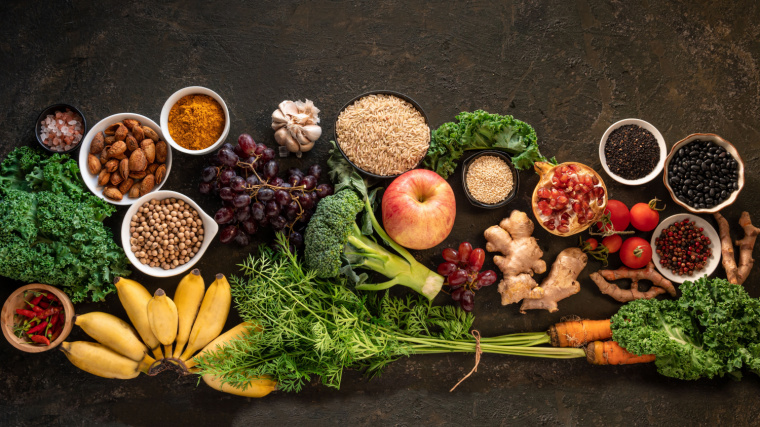
Here, we’ll get into the science behind magnesium and tell you the top magnesium-rich foods and all their nutritional info. We’ll also dive into the health benefits of magnesium and look at the research behind the daily recommended amount. You’ll want to add these healthy foods to your meal prep plans, so grab your shopping list, and let’s jump in.
- What Is Magnesium?
- Best Foods With Magnesium
- Benefits of Magnesium
- How Much Magnesium Do You Need?
- Frequently Asked Questions
What Is Magnesium?
Magnesium is an essential mineral, meaning that your body cannot make it on its own and you need to take it in through your diet. It is the fourth most common mineral after calcium, sodium, and potassium. About 50 to 60 percent of magnesium is stored in your bones; the rest is stored in your muscles and soft tissues. (1)(2)
Magnesium plays a key role in over 300 enzyme systems in your body responsible for multiple processes. Magnesium is necessary for energy production, protein synthesis, muscle contraction, nerve function, and regulating blood pressure and blood sugar levels.
The mineral impacts your heart health by helping to transport calcium and potassium. This transport impacts your nerves, muscles, and cardiac rhythm. It also contributes to your bone development. (1)(2)
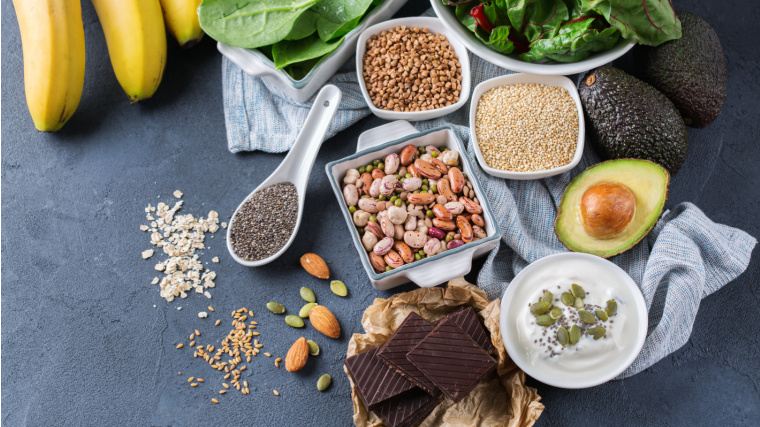
[Read More: Nutrition for Athletes — How to Eat for Muscle and Performance]
Magnesium may be particularly important to strength athletes in terms of energy production. The mineral directly affects ATP (adenosine triphosphate) metabolism, oxidative phosphorylation, and glycolysis.
Together, these three processes help generate ATP, known as the “energy currency of the cell.” Your body uses ATP for energy during short-duration, highly-intense activities like weightlifting or sprint workouts. (1)
Sources of Magnesium
Between 56 and 68 percent of Americans do not get enough magnesium through their diets to reach the recommended daily allowance (RDA). Low magnesium levels can lead to health conditions and may affect your exercise performance. (1)
Magnesium is ingestible through foods and dietary supplements. Nutritionists, dietitians, and other healthcare professionals recommend reaching your nutrient needs through food first and adding supplements when you need a little extra.
[Read More: The Definitive Guide to Bodybuilding Meal Prep]
You may get 10 percent of your daily magnesium through water; the rest comes from food and potentially supplements. Here is a quick breakdown before we dive deeper into specific foods. (3)
Food Sources of Magnesium
- Leafy green vegetables
- Nuts
- Seeds
- Legumes
- Whole grains
- Fatty fish
- Milk and soymilk
- Fruits
Types of Magnesium Supplements
- Magnesium Aspartate
- Magnesium Citrate
- Magnesium Lactate
- Magnesium Glycinate
- Magnesium Oxide
Regarding supplements, it’s best to check with your healthcare provider about which is best for you.
Best Foods With Magnesium
Hungry for strong bones, a healthy heart, and energy for weightlifting? Here are the best foods high in magnesium to add to your next meal.
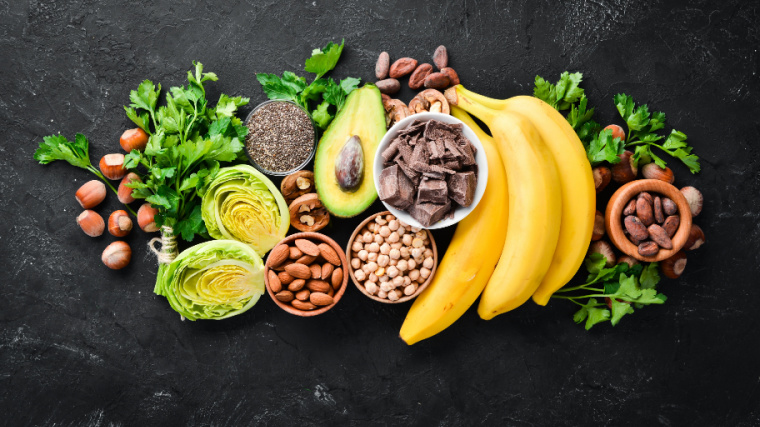
[Read More: The Best Foods for Energy Before, During, and After Your Workouts]
The nutritional information for the following foods comes from the FoodData Central database on the United States Department of Agriculture (USDA) website. (4)
Seeds
Nutrient-dense seeds are great sources of magnesium.
Pumpkin seeds are a great source of fiber, manganese, phosphorus, and vitamin K. A one-ounce serving of roasted pumpkin seeds packs 156 milligrams of magnesium, 5.27 grams of protein, 5.5 grams of fat, and 15.3 grams of carbs.
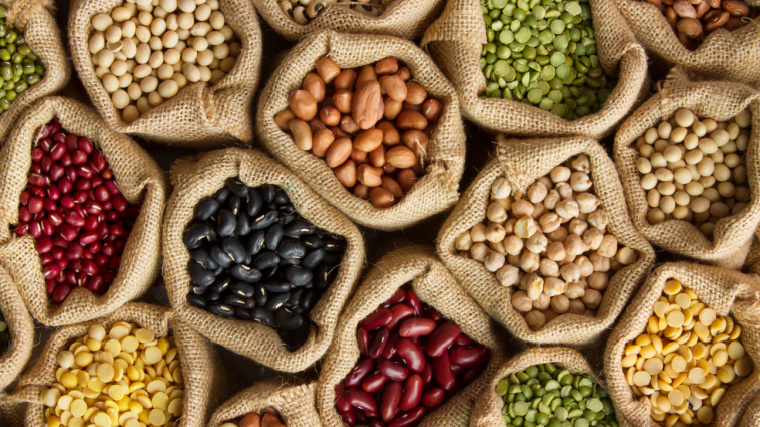
[Read More: 20 High-Fiber Foods to Support Digestion]
Chia seeds are high in antioxidants and omega-3 fatty acids. A one-ounce serving of chia seeds contains 111 milligrams of magnesium, 4.68 grams of protein, 8.7 grams of fat, and 11.9 grams of carbs.
Leafy Greens
Leafy greens, like spinach and Swiss chard, are high in magnesium and other nutrients.
Spinach contains iron, vitamin A, and fiber. A 100-gram serving of spinach has 92 milligrams of magnesium, 2.86 grams of protein, 0.39 grams of fat, and 3.63 grams of carbs.
Swiss chard is a great source of vitamin A, vitamin C, and antioxidants. A 100-gram serving of Swiss chard packs 81 milligrams of magnesium, 1.8 grams of protein, 0.2 grams of fat, and 3.75 grams of carbs.
Nuts
When you want a quick and healthy snack, nuts are a good source of magnesium. They’re also loaded with healthy fats. Nut butters also contain magnesium. Here are the best nuts to choose from.
Almonds contain antioxidants and vitamin E. A 28-gram serving of almonds contains 80 milligrams of magnesium, six grams of protein, 14 grams of fat, and 6.1 grams of carbs.
Brazil nuts are great for reducing inflammation — in addition to magnesium, they’re high in selenium and antioxidants. A 28-gram serving of Brazil nuts yields 107 milligrams of magnesium, four grams of protein, 19 grams of fat, and 3.3 grams of carbs.
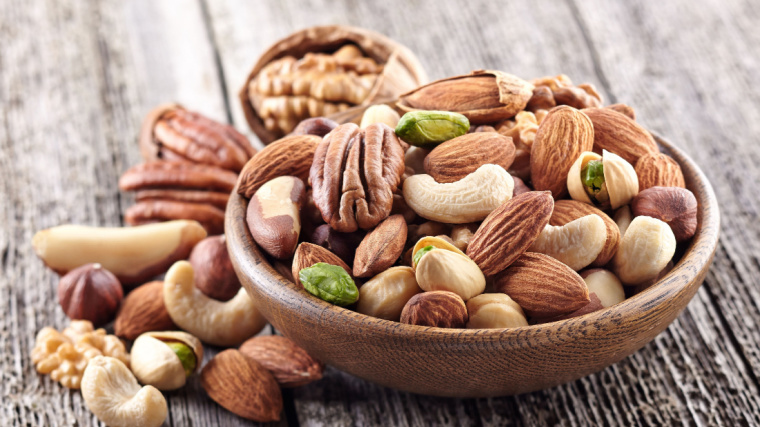
[Read More: The Best Protein Intake Calculator for Muscle Gain and Fat Loss]
Cashews contain fiber and healthy fats. A one-ounce serving of cashews has 74 milligrams of magnesium, 4.3 grams of protein, 13 grams of fat, and 9.2 grams of carbs.
Peanuts are technically legumes, but we’ll keep them with nuts. They may help lower your cholesterol. A one-ounce serving of peanuts contains 53 milligrams of magnesium, 7.3 grams of protein, 13.8 grams of fat, and 5.6 grams of carbs.
Peanut butter is a nutrient-dense, tasty addition to a protein shake. It’s a good source of B vitamins, iron, and selenium. You’ll get 61 milligrams of magnesium, 9.3 grams of protein, 12 grams of fat, and 12.8 grams of carbs for a two-tablespoon serving of peanut butter.
Soy Milk
Soy milk is a great source of magnesium. It’s also an excellent source of plant-based protein and contains potassium.
A one-cup serving of soy milk has 61 milligrams of magnesium, 7.9 grams of protein, 4.25 grams of fat, and 15.3 grams of carbs.
Legumes
Legumes are a family of vegetables that contain healthy carbs and can be a solid source of plant-based protein. The legumes family includes beans and lentils. Three types of beans are excellent sources of magnesium.
Black beans are high in fiber and antioxidants. A one-cup serving of black beans contains 120 milligrams of magnesium, 15 grams of protein, one gram of fat, and 41 grams of carbs.
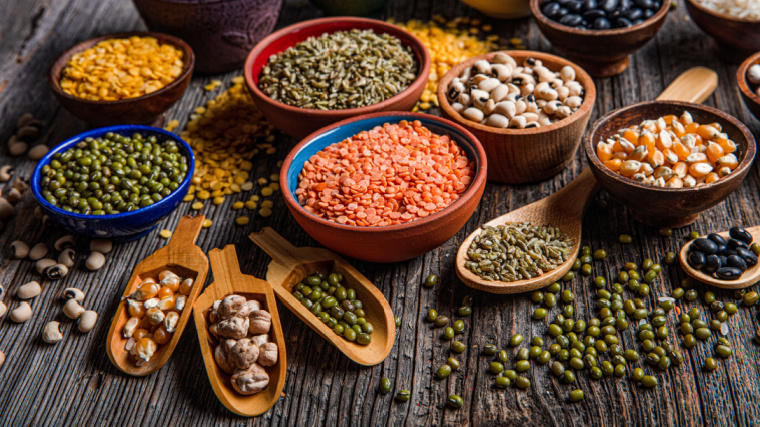
[Read More: 20 High-Protein, Low-Calorie Foods Worth Subbing Into Your Diet]
Edamame beans are a type of soybean. They contain protein, vitamin K, and folate. A one-cup serving of edamame has 100 milligrams of magnesium, 18 grams of protein, eight grams of fat, and 13.8 grams of carbs.
Kidney beans contain manganese, potassium, and iron. A one-cup serving of kidney beans contains 69 grams of magnesium, 13.4 grams of protein, 1.5 grams of fat, and 37 grams of carbohydrates.
Whole Grains
Whole grains are healthy carbs and reliable sources of magnesium. Adding brown rice or quinoa to a meal or having a sandwich with whole-wheat bread can boost your magnesium intake.
Brown rice is packed with fiber and can help you feel fuller for longer. One cup of cooked brown rice has 85.8 milligrams of magnesium, 5.5 grams of protein, 1.96 grams of fat, and 51 grams of carbs.
Quinoa is a whole grain that also works as a good vegan protein source. It’s also packed with other nutrients like fiber, folate, zinc, and antioxidants. A one-cup serving of quinoa has 118 milligrams of magnesium, 8.1 grams of protein, 3.5 grams of fat, and 39.4 grams of carbs.
Whole wheat bread is a good source of fiber. One slice of whole-wheat bread contains 24 milligrams of magnesium, 3.9 grams of protein, 1.1 grams of fat, and 13.7 grams of carbs.
Fatty Fish
Fatty fishes like salmon, halibut, and mackerel are great sources of magnesium and omega-3 fatty acids. Omega-3s can boost your heart health and improve your muscle recovery. (5)(6)
In addition to omega-3s and magnesium, salmon is high in B vitamins, selenium, and phosphorus. A three-ounce serving of salmon has 23 milligrams of magnesium, 17 grams of protein, and five grams of fat.
Halibut is similarly rich in omega-3s, B vitamins, and selenium. A three-ounce serving of halibut contains 28 milligrams of magnesium, 15.6 grams of protein, and 15 grams of fat.

Mackerel is a super oily fish, making it extra high in omega-3 fatty acids. Eating mackerel may help lower your cholesterol and blood pressure. A one-cup serving of cooked mackerel contains 81.6 milligrams of magnesium, 25.2 grams of protein, and 34.1 grams of fat.
Apples
Fruits aren’t particularly high in magnesium, but they’re still healthy. Apples have the highest amount of magnesium and other nutrients like fiber and antioxidants.
A medium-sized apple has nine milligrams of magnesium, 27.6 grams of carbs, 0.5 grams of protein, and 0.3 grams of fat.
Dark Chocolate
Great news for chocolate lovers — dark chocolate is a pretty high source of magnesium, especially if it has a high cacao percentage. Some consider cacao seeds a “superfood” because they contain polyphenols, flavanols, and antioxidants. Eating dark chocolate may help boost your cardiovascular health. (7)(8)

A one-ounce serving of dark chocolate with 60 percent cacao contains 49.9 milligrams of magnesium, 1.7 grams of protein, 10.9 grams of fat, and 14.9 grams of carbs.
Benefits of Magnesium
Magnesium is critical to several important systems in your body. Getting enough magnesium can help with energy production, protect your heart health, regulate your blood pressure and blood sugar, and strengthen your bones.
Helps With Energy Production
Research shows that many athletes do not get enough magnesium in their diets. Magnesium is important for energy production and storage, healthy muscle function, and protein synthesis. (9)(10)
Some studies suggest that magnesium levels may affect exercise performance in older adults. They show a positive link between magnesium levels and muscle performance, leg power, grip strength, ankle strength, trunk flexion and rotation, and jumping. (11)
[Read More: The Best Foods for Energy Before, During, and After Your Workouts]
These movements — like power and jumping — require ATP for energy. ATP is stored in your body and burns out naturally after a few seconds when you do a highly intense activity. Having adequate magnesium levels may help with replenishing your ATP. (12)
Improves Heart Health
Low magnesium levels are associated with an increased risk of heart conditions, particularly arteriosclerosis, a thickening and hardening of your blood vessels. (1)
Low magnesium can contribute to a calcium buildup in your heart vessels and a decrease of HDL (high-density lipoprotein) cholesterol, or “good” cholesterol. HDL cholesterol carries “bad” cholesterol away from your heart. The calcium buildup blocks your blood vessels from transporting blood, oxygen, and nutrients to the rest of your body. (1)

Since magnesium is involved with transporting calcium, it can help to keep your arteries clear and reduce calcium accumulation. Magnesium may also increase nitric oxide production, leading to more vasodilation — a relaxing and widening of your blood vessels. More vasodilation can improve blood flow and boost your heart health. (1)
People with a higher magnesium intake may have a 77 percent reduction in sudden death from a cardiac issue. (1)
Helps Regulate Blood Pressure
Magnesium helps transport calcium away from your heart, increases nitric oxide, and relaxes blood vessels. This process may also help to lower your blood pressure. (10)
Although magnesium helps to regulate blood pressure, clinical trials show that magnesium supplements may not be enough treatment for high blood pressure or hypertension. Increasing magnesium and potassium while reducing dietary sodium may be more effective than only focusing on magnesium. (3)(13)
May Help Regulate Blood Sugar
Magnesium plays an important role in metabolizing glucose or blood sugar. Low magnesium levels can increase insulin resistance. High blood sugar levels and insulin resistance can lead to type 2 diabetes. Diets high in magnesium may reduce your risk of developing type 2 diabetes. (2)(3)
However, for people who have type 2 diabetes, magnesium supplementation alone may not be enough to help manage your condition. The American Diabetes Association states that there is insufficient evidence to use magnesium supplements to help regulate blood sugar levels and glucose control. (14)
Medical nutrition therapy (MNT) can help people with type 2 diabetes manage their diet to improve their blood sugar levels and other markers of diabetes. Eating foods rich in magnesium is part of an overall healthy diet, but MNT personalizes advice to each individual. (14)
Boosts Bone Health
Since 60 percent of your body’s magnesium is in your bones, it makes sense that adequate magnesium levels contribute to your bone health. Many studies have found an association between high magnesium levels and high bone mineral density in people of all ages and genders. (2)(3)
Cisgender women may be more likely to develop osteoporosis, a decrease in bone mineral density and bone mass, as they age. Osteoporosis can increase your risk of fractures. Research links a magnesium deficiency with an increased risk of developing osteoporosis. (2)

Some studies show that eating foods rich in magnesium or taking supplements can improve bone mineral density in postmenopausal people and people with osteoporosis. Higher bone mineral density leads to better bone health and may reduce the risk of fractures. (2)(3)
For optimal bone health for people at risk of osteoporosis, consuming a diet rich in vitamin D, calcium, and protein is essential. Weight-bearing cardio exercises and muscle-strengthening exercises are also important in managing and preventing osteoporosis. Adequate magnesium intake is one crucial piece of the puzzle for bone health. (15)
How Much Magnesium Do You Need?
The United States Food and Nutrition Board recommends different amounts of magnesium based on a person’s age and gender assigned at birth. (3)
- Cisgender men, aged 19 to 30: 400 milligrams per day
- Cisgender women, aged 19 to 30: 310 milligrams per day
- Cisgender men over 30: 420 milligrams per day
- Cisgender women over 30: 320 milligrams per day
If you are pregnant or breastfeeding, the recommendations vary slightly:
- Pregnant people, aged 19 to 30: 350 milligrams per day
- Pregnant people over 30: 360 milligrams per day
- Breastfeeding, age 19 to 30: 310 milligrams per day
- Breastfeeding over 30: 320 milligrams per day
Incorporating foods high in magnesium into your diet can help you reach the recommended daily amount, and adding supplements can give you an extra boost. Be sure to discuss any supplementation with a doctor, particularly if you are pregnant or breastfeeding.
Energize
Magnesium is an essential mineral that your body needs to create energy. It can also play a significant role in bone health, heart health, and preventing chronic health conditions. Including magnesium-rich foods in your diet can help keep you energized, strong, and healthy.
Strength athletes should be sure to reach the recommended daily amount — about 320 milligrams daily for adult cisgender women and 420 milligrams per day for adult cisgender men. Pile lots of leafy greens onto your plate and include seeds, nuts, legumes, whole grains, and apples in your diet to boost your magnesium levels naturally. Eat up, lift heavy, and feel good.
FAQs
Here are answers to some common questions on foods with magnesium.
All of the foods on our list are the highest sources of magnesium from each food group — but pumpkin seeds win with 156 milligrams of magnesium per serving.
It’s best to consult with a healthcare provider to determine if you need a magnesium supplement and to help decide which would be best for you.
Magnesium citrate is a popular magnesium supplement because it can be absorbed quickly. Magnesium oxide takes longer to absorb but may contain more milligrams of magnesium per dose.
References
- Schwalfenberg GK, Genuis SJ. The Importance of Magnesium in Clinical Healthcare. Scientifica (Cairo). 2017;2017:4179326.
- U.S. Department of Health and Human Services. Magnesium Fact Sheet for Health Professionals. National Institutes of Health.
- Al Alawi AM, Majoni SW, Falhammar H. Magnesium and Human Health: Perspectives and Research Directions. Int J Endocrinol. 2018 Apr 16;2018:9041694.
- USDA. FoodData Central. U.S. Department of Agriculture.
- DiNicolantonio JJ, O’Keefe JH. The Benefits of Marine Omega-3s for the Prevention and Treatment of Cardiovascular Disease. Mo Med. 2019 Sep-Oct;116(5):404-408.
- Gammone MA, Riccioni G, Parrinello G, D’Orazio N. Omega-3 Polyunsaturated Fatty Acids: Benefits and Endpoints in Sport. Nutrients. 2018 Dec 27;11(1):46.
- Crozier SJ, Preston AG, Hurst JW, Payne MJ, Mann J, Hainly L, Miller DL. Cacao seeds are a “Super Fruit”: A comparative analysis of various fruit powders and products. Chem Cent J. 2011 Feb 7;5:5.
- Charalambos Vlachopoulos, Konstantinos Aznaouridis, Nikolaos Alexopoulos, Emmanuel Economou, Ioanna Andreadou, Christodoulos Stefanadis, Effect of Dark Chocolate on Arterial Function in Healthy Individuals, American Journal of Hypertension, Volume 18, Issue 6, June 2005, Pages 785–791.
- Volpe SL. Magnesium and the Athlete. Curr Sports Med Rep. 2015 Jul-Aug;14(4):279-83.
- Fiorentini D, Cappadone C, Farruggia G, Prata C. Magnesium: Biochemistry, Nutrition, Detection, and Social Impact of Diseases Linked to Its Deficiency. Nutrients. 2021 Mar 30;13(4):1136.
- Zhang Y, Xun P, Wang R, Mao L, He K. Can Magnesium Enhance Exercise Performance? Nutrients. 2017 Aug 28;9(9):946.
- Dunn J, Grider MH. Physiology, Adenosine Triphosphate. [Updated 2023 Feb 13]. In: StatPearls [Internet]. Treasure Island (FL): StatPearls Publishing; 2023 Jan-.
- Houston M. The role of magnesium in hypertension and cardiovascular disease. J Clin Hypertens (Greenwich). 2011 Nov;13(11):843-7.
- Evert AB, Boucher JL, Cypress M, Dunbar SA, Franz MJ, Mayer-Davis EJ, Neumiller JJ, Nwankwo R, Verdi CL, Urbanski P, Yancy WS Jr; American Diabetes Association. Nutrition therapy recommendations for the management of adults with diabetes. Diabetes Care. 2013 Nov;36(11):3821-42.
- Benedetti MG, Furlini G, Zati A, Letizia Mauro G. The Effectiveness of Physical Exercise on Bone Density in Osteoporotic Patients. Biomed Res Int. 2018 Dec 23;2018:4840531.
Featured Image: Lesterman / Shutterstock
The post The Best Foods High in Magnesium for More Energy in the Gym appeared first on BarBend.
